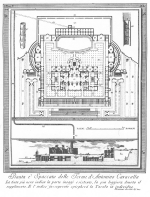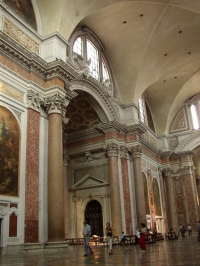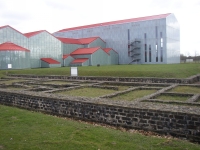


Bath
Roman baths were part of the day-to-day life in ancient Rome. Some private Roman houses had water supplied via lead pipes but only by special permission of the caesar or other officials so private baths were scarce. For personal hygiene, people went to public baths. These local bath complexes were also a gathering point and served a very useful community and social function. Here people could relax, keep clean and keep up with the latest news.Taking a bath was not a simple job. A visitor could use a cold bath (frigidarium), a warm bath (tepidarium) and a hot bath (caldarium). A visitor would spend some of his time in each one before leaving. A large complex would also contain an exercise area (the palaestra), a swimming pool and a gymnasium. One of the public baths at Pompeii contains two tepidariums and caldariums along with a plunge pool and a large exercise area.
Recent studies show that - contrary to the common view - there was not a standard lay-out in baths buildings, although people were accustomed to a more or less standard usage of the different baths (cold, warm, hot etc).
From the 2nd century the public baths themselves could be huge. A complex built by the emperor Diocletian was the size of a football-field. Those who paid for the construction wanted to make a statement, so that many baths contained mosaics and massive marble columns. The larger baths contained statues to the gods and professionals were on hand to help take the strain out of having a bath. Masseurs would massage visitors and then rub scented olive oil into their skin.
The building of a bath complex required excellent engineering skills. Baths required a way of heating up water which was done by using a furnace and the hypocaust system carried the heat around the complex. The dirty water in the baths was actually drained and replaced regularly. So water had to be constantly supplied. In Rome this was done using water from one of the 11 aqueducts. The catchment areas of some aqueducts were even expanded with extra sources, like the caesars Septimius Severus (CIL 6.1247) and Caracalla (CIL 6.1245) did with the Aqua Marcia, because of the extreme demand of the new, huge baths complexes.
Caesar Diocletian and others opt for an other solution by restoring the channels and adding huge water reservoirs / storage basins to their baths complexes so the water supplied at night was used to feed the baths by day.
Apart from the 'traditional' baths, also some thermal baths arose, some of which with a sacred meaning. The natural hot springs in Bath (UK; in Latin: Aquae Sulis) attracted Roman settlement from the first century and the town soon developed as a spa, with the waters dedicated to Sulis-Minerva, a combination of a native and Roman deity. The focal point of the baths is the sacred spring, with its surrounding reservoir, from which the water emerges at 46,5 degree C. North-west of the reservoir was the temple of the deity Sulis-Minerva.